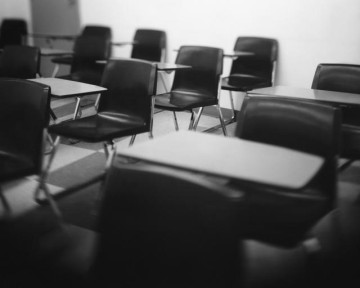Over 50% of Dropouts Come From Just 12 RI Schools
Wednesday, May 30, 2012
Yajaira Cortes was only 16 when she became another statistic at what she refers to as Mount Pregnant High School.
That was ten years ago. Then a junior at Mount Pleasant, she recalls receiving little support at home and even less at school once it was clear she had a child on the way. With the world giving up on her, she gave in. School became an afterthought.
“I was really discouraged,” she said. “I didn’t know about any of my options.”
GET THE LATEST BREAKING NEWS HERE -- SIGN UP FOR GOLOCAL FREE DAILY EBLASTYajaira’s story is hardly unique.
In the last four years alone, just over 7,800 students have dropped out of school in Rhode Island. Of that number, over 50 percent (3,996) come from just 12 high schools, according to a GoLocalProv analysis of 5-year cohort dropout rates between the class of 2008 and the class of 2011. Depending on the year Rhode Island had between 58 and 62 public high schools.
The schools that produce the most dropouts come as little surprise. Mostly urban. Mostly overcrowded. 547 dropouts came from Woonsocket, another 472 from Mount Pleasant. 351 came from Central Falls. Pawtucket’s struggling high schools (Tolman and Shea) have produced a combined 722 dropouts. The larger schools, such as East Providence, Coventry and Cranston East also make the list.
Unacceptable Numbers
Rhode Island’s struggles are part of a nationwide epidemic that has one in four students not completing high school on time, according to researchers at the Everyone Graduates Center at Johns Hopkins University. As of 2009, the dropout rate among minority students was 40 percent.
For Dr. Robert Balfanz, the co-director of the Everyone Graduates Center, the numbers are simply unacceptable.
“[We] need to design the school to meet the educational challenge it faces, so if it knows most students are coming in behind grade level and with poor attendance in middle school, it needs supports from day one to help kids get to school and to close their knowledge and skill gaps,” Balfanz told GoLocalProv in an interview. “So if 100 students are reading at 5th grade level, need to make sure, you have the capacity to offer all 100 the appropriate extra supports.”
But offering that much support to struggling students and turning around dropout factories –the schools that graduate less than 60 percent of their students— can be easier said than done. With new measurers seemingly being implemented every year, educators have become increasingly skeptical of school reform efforts, particularly when outcomes are largely decided by test scores.
Balfanz said a positive culture in schools is vital.
“There is a lot a school can do to propel students to come, behave and try,” he said. “Building a strong can do culture among students and staff, and providing sufficient student supports so all students in need have someone [to look up to is important].”
More Than One Answer
According to Denise Jenkins, who oversees education grants at the Rhode Island Foundation, the key is also knowing that “there is not just one answer to the dropout question.”
Jenkins said Rhode Island has taken steps to implement a teacher evaluation system that is now being implemented across the state. At the same time, the Rhode Island Foundation recently offered a grant that helped to create United Providence, a first-of-its-kind labor-management compact between the Providence Public School District and the Providence Teachers Union that is drawing national attention.
According to Education Commissioner Deborah Gist, ensuring that schools are exciting and engaging places where students and teachers share a culture of learning and high achievement a Gist pointed to the turnaround at Central Falls High School, which improved its graduation rate by 17 percentage points in 2011, as a success story in the state.
She credited the school with doing whatever it takes to make sure students succeed, which includes offering Saturday and summer classes to help students catch up and providing over 70 hours of extra tutoring each for students at risk of falling off track.
“Overall, the schools that are improving their graduation rates and reducing the dropout rates are acting with urgency, engaging students and families, and connecting students with the services they need to rapidly accelerate their learning,” Gist said.
Gist said the state will soon begin implementing a new diploma system that requires schools to provide students who fail to demonstrate partial proficiency with intensive support to improve their performance.
“We need to ensure that our students who graduate from high school are truly prepared for success in college and in challenging careers, and we also share the responsibility of providing all students with every opportunity to earn a high-school diploma,” she said.
An Economic Incentive
Gist said her goal is to raise the statewide graduation rate to 85 percent by 2015. Last year, the 5-year rate was 80 percent. By 2020, the America’s Promise Alliance hopes to raise the national graduation rate to 90 percent.
The incentive to improving the graduation rate is two-fold: More high school graduates means a more educated workforce that will be able to compete in the global economy. Perhaps more directly, reducing the number of dropouts in the state and across the country will save taxpayers billions.
“Adults who do not graduate from high school are more likely to be unemployed, live in poverty, receive public assistance, be involved in criminal activity and have poor physical and emotional health than those who graduate,” said Elizabeth Burke Bryant, executive director of Rhode Island Kids Count.
According to a 2009 study published by the Education Equality Project, the expected lifetime earnings of a high school dropout is $827,438; the expected earnings of a high school graduate is $1.2 million. The expected lifetime costs to the state of a dropout, between public assistance and incarceration, is $440,214.
Yajaira has firsthand knowledge of what a dropout can cost the state. With few skills, no diploma and a child to take care of, finding a job was nearly impossible. She was forced to turn to public assistance.
“It was really hard,” she recalls. “I had temp jobs but couldn’t find much. Not have any experience always put me at the bottom of the food chain.”
Alternative Programs the Answer?
But Yajaira found an answer.
At age 24, still without even her GED, she walked through the doors at Youthbuild Providence. An alternative education and workforce-development program that helps high school dropouts gain the literacy and job-readiness, Youthbuild is among several programs in the city that are helping young people get back on track with their lives.
With the support of the Youthbuild staff, she earned a GED and is now a student at the Community College of Rhode Island. She hopes to become a social worker.
She said she wants to begin working with students who are experiencing the same problems she faced a decade ago. With thousands of Rhode Islanders still dropping out each year, Yajaira hopes to help students defy the odds.
“I like to help others,” she said. “I want them to know there’s a light at the end of the tunnel.”
Dan McGowan can be reached at [email protected].
Related Articles
- 40 Percent Of Providence Schools Could Be Failing
- Providence Schools in Crisis: 37% of Students are ‘Chronically Absent’
- Chronic Absenteeism Plagues Urban High Schools





